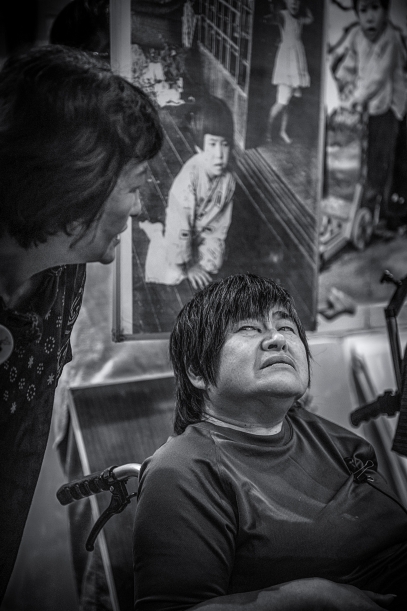

Kiyoko Kagata is a Minamata disease victim. When she was 7, she began to show signs of the disease and was taken to a hospital for tests. She never left, and has lived there her entire life. The isolation she felt initially was devastating. As years passed and younger patients arrived whose family memories were also aborted, Kiyoko decided to help them, consoling them as an older sister. With the director of Hot House, Takeko Kato, Kiyoko and other congenital victims tell their stories with the hope of preventing further industrial pollution tragedies.
Minamata’s Living Legacy
Photographer: Mick Stetson
Exhibit Title: Minamata’s Living Legacy
Location: Japan
A visual record of the devastating results of the Chisso-Minamata Disease, as it continues to be lived by the few surviving victims and their community.
Imagine an enemy, bold and brazen, in front of your eyes, yet hidden. The enemy secretly poisons the sea that feeds you, hides the evidence and continues to flush the sea with its toxins for the next 10 years. The poison? — organic (methyl) mercury which erodes the part of the brain that controls the central nervous system. When it is absorbed through a mother’s placenta, the mother escapes the crippling horrors of mercury poisoning, but the unborn infant carries the brunt of this violence until the day they die.
One of the goals of this project is to create a collective memory of the aftermath of this tragic event. To remind the world that without the survivors’ lives as a testimony, unbridled capitalism will continue to make decisions that favor profit, and disregard the impact of their actions on nature and the people who live within it.
In my mind’s eye, I see Minamata’s Living Legacy as a sequel to Eugene and Aileen Smith’s internationally renowned, “Minamata.” Their work dramatically alerted the world to the dangers of mercury poisoning as well as documenting the victim’s struggle with bringing the Chisso Corporation to justice. However, the focus of Minamata’s Living Legacy lies within these questions: How will the victims continue to survive in the aftermath? How will they surmount the physical limitations that were imposed on them? Does a monetary compensation resolve or remedy the situation?
Although I began this project more than 12 years ago, I have only scratched the surface. With additional resources, I hope to accomplish more thoroughly the following:
The 1950s: Most fisher families in Minamata were poor, living in huts crowding the shoreline, eking out a modest living from the Shiranui Sea. Searching the beaches for clams and other edible shellfish was a favorite pastime for local families. The children racing through the shallow water, their screaming, laughing voices declaring what they have found.
Then the rumors began. In the villages around Hyakken Harbor, the cats were dancing, whirling in rapid circles, running head-on into rocks and trees. Eventually they hurled themselves into the sea. Soon after, many kinds of fish were floating, belly-up in the morning sea. The children splashed through the water, catching them in their hands. When they became bored, they ran further down the beach where they saw crows flying, one suddenly drops from the sky into the ocean. As the fish disappeared, the fisher families lost their livelihood, and what little they could glean from the Shiranui Sea became their only food source.
1968: By the time the government announced that Chisso Corporation’s effluent caused Minamata disease, there were almost 3,000 known victims, and many others who were not yet identified.
The Minamata incident is one of many anthropogenic environmental disasters that have occurred during the past 100 years, Japan’s second: the Fukushima Daiichi nuclear disaster that in many ways resembles the Minamata tragedy. One of the goals of this project is to create a collective memory of the aftermath of this tragic event. To remind the world that without the survivors’ lives as a testimony, unbridled capitalism will continue to make decisions that favor profit, and disregard the impact of their actions on nature and the people who live within it.
Make Comment/View Comments